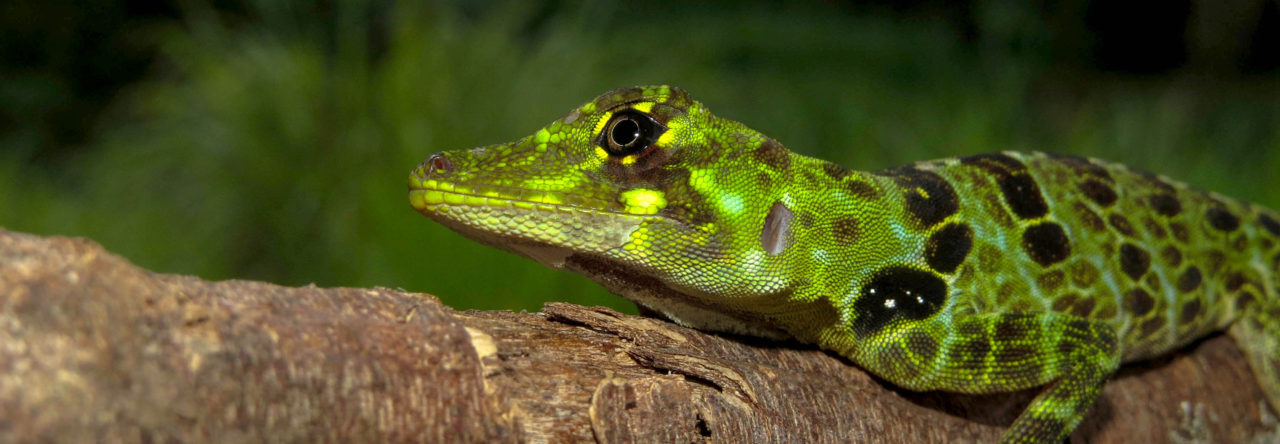
Seaweed washed ashore on a Bahamian island. Photo by Dave Spiller.
Ecologists are increasingly recognizing the myriad connections not only among species within an ecosystem, but between species in different ecosystems. Case in point: seaweed often washes ashore, and it affects leaves on the plants found near the shoreline. How’s that, you might ask? Well, the seaweed decays and releases nutrients that act as fertilizer, increasing the growth of land plants. That’s good for the plants, but it also makes their leaves more tasty, and hence plant-eating insects are attracted and cause more damage to the leaves.
That seems straightforward enough, but then it gets more complicated. As the seaweed decays, it attracts lots of insects. And the insects, in turn, attract lizards. And, in fact, if you happen to be studying this process on small islands in the Bahamas, as Jonah Piovia-Scott and a team from UC-Davis were, then those lizards are our favorites, brown anoles. And if there are more brown anoles around, then they’ll eat more of the herbivorous insects that plague the land plants, and so the washed-up seaweed actually decrease the damage to land plant leaves, thanks to the helpful consumption of the anoles.
Except…maybe the lizards will be so delighted by the seaweed that they’ll spend all of their time there, eating the insects on the seaweed, and thus neglecting the insects on the landplants, so now the effect of seaweed on the land plants becomes negative again.
 So which is it? That’s what Piovia-Scott et al. set out to discover, and they’ve just reported the results in a paper in Oecologia. And the diagram to the left explains it succinctly. Seaweed increases nitrogen in the leaves, which increases herbivory. Seaweed also increases lizard density, which decreases herbivory, though the negative effect isn’t as great as the positive effect of the nitrogen. Moreover, seaweed also causes lizards to shift their diet, which has a small (and statistically non-significant) positive effect on herbivory because the lizards aren’t eating as many of the land plant herbivores. Bottom line: seaweed increases leaf damage; lizards can’t prevent it, in part because their effects are schizophrenic: more lizards, but eating fewer herbivores.
So which is it? That’s what Piovia-Scott et al. set out to discover, and they’ve just reported the results in a paper in Oecologia. And the diagram to the left explains it succinctly. Seaweed increases nitrogen in the leaves, which increases herbivory. Seaweed also increases lizard density, which decreases herbivory, though the negative effect isn’t as great as the positive effect of the nitrogen. Moreover, seaweed also causes lizards to shift their diet, which has a small (and statistically non-significant) positive effect on herbivory because the lizards aren’t eating as many of the land plant herbivores. Bottom line: seaweed increases leaf damage; lizards can’t prevent it, in part because their effects are schizophrenic: more lizards, but eating fewer herbivores.
Interestingly, these results are opposite of what the same team of authors found in a study we discussed two years ago. The difference was that in that study, a big pile of seaweed was laid out at one time and the results were followed over a short period, whereas this study followed natural seaweed deposition and compared sites differing in the amount of seaweed washed ashore, following their sites for a lengthier period of time.
One last point: how did the researchers document that the lizards were switching diet? Not from sitting around and watching the lizards, but by measuring the carbon isotope ratios in their tails. Marine vegetation tends to have higher ratios of Carbon-13 than terrestrial sources, and so insects feeding on plants from different areas will, in turn, have different ratios, which means that, in turn, one can look at the Carbon-13 ratios in lizard tissue and get a sense of from which ecosystem they’re deriving their carbon. And in this case, the more seaweed, the higher the ratio. Pretty nifty!




















 This, in turn, reminds us of
This, in turn, reminds us of 

 Periodically, we’ve discussed how green and brown anoles interact now that they’ve been thrown into sympatry in the southeastern U.S. and elsewhere–do they
Periodically, we’ve discussed how green and brown anoles interact now that they’ve been thrown into sympatry in the southeastern U.S. and elsewhere–do they